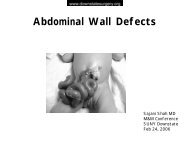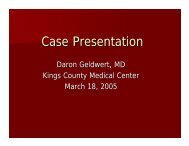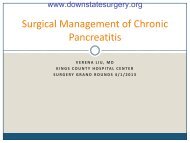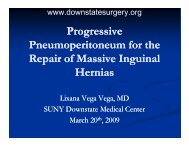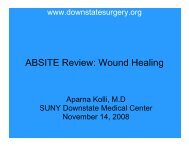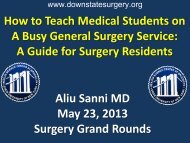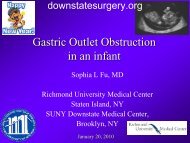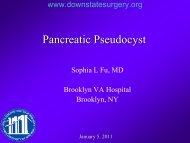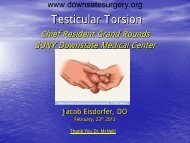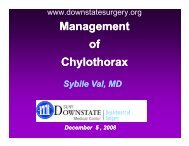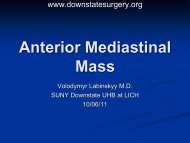Copyright © 2004 Pearson Education, Inc., publishing as Benjamin ...
Copyright © 2004 Pearson Education, Inc., publishing as Benjamin ...
Copyright © 2004 Pearson Education, Inc., publishing as Benjamin ...
You also want an ePaper? Increase the reach of your titles
YUMPU automatically turns print PDFs into web optimized ePapers that Google loves.
<strong>Copyright</strong> © <strong>2004</strong> <strong>Pearson</strong> <strong>Education</strong>, <strong>Inc</strong>., <strong>publishing</strong> <strong>as</strong> <strong>Benjamin</strong> Cummings
C<strong>as</strong>e Presentation<br />
• A **year-old female w<strong>as</strong> admited for elective superficial<br />
parotidectomy.<br />
• Patient presented with a history of an painless, slowlygrowing<br />
left-sided lateral cheek m<strong>as</strong>s.<br />
<strong>Copyright</strong> © <strong>2004</strong> <strong>Pearson</strong> <strong>Education</strong>, <strong>Inc</strong>., <strong>publishing</strong> <strong>as</strong> <strong>Benjamin</strong> Cummings
Hx<br />
• PMHx: HTN<br />
• PSHx: C-section 20y ago<br />
• Allergies: NKDA<br />
• Meds: Norv<strong>as</strong>c 5mg QD<br />
• Social Hx: denies smoking, alcohol, denies IVDA<br />
<strong>Copyright</strong> © <strong>2004</strong> <strong>Pearson</strong> <strong>Education</strong>, <strong>Inc</strong>., <strong>publishing</strong> <strong>as</strong> <strong>Benjamin</strong> Cummings
• A&OX3, anicteric<br />
• Cardiac: S1/S2 RRR<br />
• Lungs: CTA B/L<br />
PE<br />
• Abdominal exam:soft, NT, ND, +BS, no m<strong>as</strong>ses<br />
• Neurological exam: no focal abnormalities, nystagmus,<br />
abnormal ocular movements, gait disturbance, or<br />
peripheral neuropathy<br />
<strong>Copyright</strong> © <strong>2004</strong> <strong>Pearson</strong> <strong>Education</strong>, <strong>Inc</strong>., <strong>publishing</strong> <strong>as</strong> <strong>Benjamin</strong> Cummings
PE<br />
• 4 cm × 3 cm firm polinodular m<strong>as</strong>s, not adherent to deep<br />
and superficial tissues in the left parotid area that<br />
surrounded the left external auditory canal.<br />
• No eviedence of facial paralysis.<br />
• Palpation of the neck w<strong>as</strong> unremarkable.<br />
<strong>Copyright</strong> © <strong>2004</strong> <strong>Pearson</strong> <strong>Education</strong>, <strong>Inc</strong>., <strong>publishing</strong> <strong>as</strong> <strong>Benjamin</strong> Cummings
Fine Needle Aspiration Cytology<br />
• (FNAC) showed pleomorphic adenoma of the parotid<br />
gland<br />
<strong>Copyright</strong> © <strong>2004</strong> <strong>Pearson</strong> <strong>Education</strong>, <strong>Inc</strong>., <strong>publishing</strong> <strong>as</strong> <strong>Benjamin</strong> Cummings
OR<br />
•The The patient subsequently underwent<br />
superficial parotidectomy.<br />
•POD#1: POD#1: D/C home<br />
<strong>Copyright</strong> © <strong>2004</strong> <strong>Pearson</strong> <strong>Education</strong>, <strong>Inc</strong>., <strong>publishing</strong> <strong>as</strong> <strong>Benjamin</strong> Cummings
Pathology<br />
• Pleomorphic adenoma<br />
of the parotid gland,<br />
myxoid type:<br />
abundant myxoid<br />
ground-substance with<br />
interspersed spindle<br />
and stellate cells.<br />
<strong>Copyright</strong> © <strong>2004</strong> <strong>Pearson</strong> <strong>Education</strong>, <strong>Inc</strong>., <strong>publishing</strong> <strong>as</strong> <strong>Benjamin</strong> Cummings
<strong>Copyright</strong> © <strong>2004</strong> <strong>Pearson</strong> <strong>Education</strong>, <strong>Inc</strong>., <strong>publishing</strong> <strong>as</strong> <strong>Benjamin</strong> Cummings<br />
Anatomy
Salivary Gland Tumors (SGTs)<br />
• Arise from either<br />
• Major salivary glands<br />
(parotid,<br />
submandibular, and<br />
sublingual)<br />
pleomorphic adenoma of submandibular gland<br />
• Minor salivary glands<br />
which are located<br />
throughout the<br />
submucosa of the upper<br />
aerodigestive tract.<br />
<strong>Copyright</strong> © <strong>2004</strong> <strong>Pearson</strong> <strong>Education</strong>, <strong>Inc</strong>., <strong>publishing</strong> <strong>as</strong> <strong>Benjamin</strong> Cummings
Salivary Gland Tumors (SGTs)<br />
• Parotid gland (70-85%)<br />
• submandibular gland (8-<br />
15%)<br />
• sublingual gland (
Salivary Gland Tumors (SGTs)<br />
• Arise from either<br />
• Major salivary glands<br />
(parotid, submandibular, and<br />
sublingual)<br />
• Minor salivary glands which<br />
are located throughout the<br />
submucosa of the upper<br />
aerodigestive tract.<br />
pleomorphic adenoma of<br />
submandibular gland<br />
<strong>Copyright</strong> © <strong>2004</strong> <strong>Pearson</strong> <strong>Education</strong>, <strong>Inc</strong>., <strong>publishing</strong> <strong>as</strong> <strong>Benjamin</strong> Cummings
• 15-25% of all parotid tumors<br />
Malignancy %<br />
• 37-43 %f submandibular gland tumors<br />
• >80 % of the minor salivary gland tumors<br />
• As a general rule, the smaller the<br />
salivary gland in adults,<br />
the higher the probability that a<br />
neopl<strong>as</strong>m arising in such a<br />
gland is malignant<br />
• Spiro RH (Salivary neopl<strong>as</strong>ms:<br />
overview of a 35-year experience with<br />
2,807 patients)Head Neck Surg 1986<br />
;8(3):177-84.<br />
<strong>Copyright</strong> © <strong>2004</strong> <strong>Pearson</strong> <strong>Education</strong>, <strong>Inc</strong>., <strong>publishing</strong> <strong>as</strong> <strong>Benjamin</strong> Cummings<br />
Figure 11.11
<strong>Copyright</strong> © <strong>2004</strong> <strong>Pearson</strong> <strong>Education</strong>, <strong>Inc</strong>., <strong>publishing</strong> <strong>as</strong> <strong>Benjamin</strong> Cummings
<strong>Copyright</strong> © <strong>2004</strong> <strong>Pearson</strong> <strong>Education</strong>, <strong>Inc</strong>., <strong>publishing</strong> <strong>as</strong> <strong>Benjamin</strong> Cummings
<strong>Copyright</strong> © <strong>2004</strong> <strong>Pearson</strong> <strong>Education</strong>, <strong>Inc</strong>., <strong>publishing</strong> <strong>as</strong> <strong>Benjamin</strong> Cummings
Statistics<br />
• 3-6% of all head and<br />
neck neopl<strong>as</strong>ms<br />
• <strong>Inc</strong>idence of 1-3 per<br />
100,000 people per<br />
year<br />
<strong>Copyright</strong> © <strong>2004</strong> <strong>Pearson</strong> <strong>Education</strong>, <strong>Inc</strong>., <strong>publishing</strong> <strong>as</strong> <strong>Benjamin</strong> Cummings
Age<br />
• The mean age at<br />
presentation<br />
• Ca 55 – 65y<br />
• benign lesions (a<br />
decade earlier, 45 y)<br />
<strong>Copyright</strong> © <strong>2004</strong> <strong>Pearson</strong> <strong>Education</strong>, <strong>Inc</strong>., <strong>publishing</strong> <strong>as</strong> <strong>Benjamin</strong> Cummings
Risk Factors for Carcinogenesis<br />
• not well understood<br />
• Radiation exposure<br />
• EBV<br />
• Environmental :<br />
• silica dust<br />
• Kerosene<br />
<strong>Copyright</strong> © <strong>2004</strong> <strong>Pearson</strong> <strong>Education</strong>, <strong>Inc</strong>., <strong>publishing</strong> <strong>as</strong> <strong>Benjamin</strong> Cummings<br />
• Genetic (inactivation<br />
of the tumor<br />
suppressor gene<br />
p16INK4A)<br />
• Dietary:reduced<br />
intake of fruits and<br />
vegetables
Risk Factors for Carcinogenesis<br />
• <strong>Inc</strong>idence of salivary gland<br />
tumors w<strong>as</strong> studied in a<br />
cohort of 2945 individuals<br />
who were irradiated between<br />
1939 and 1962 (during<br />
childhood) for tonsillitis,<br />
acne, or chronic ear dise<strong>as</strong>e.<br />
• 3% developed salivary gland<br />
neopl<strong>as</strong>ms,<br />
• 90 % in parotid glands.<br />
• Mucoepidermoid carcinom<strong>as</strong><br />
MC malignancy<br />
• Mixed (pleomorphic)<br />
adenom<strong>as</strong> MC benign<br />
neopl<strong>as</strong>m<br />
<strong>Copyright</strong> © <strong>2004</strong> <strong>Pearson</strong> <strong>Education</strong>, <strong>Inc</strong>., <strong>publishing</strong> <strong>as</strong> <strong>Benjamin</strong> Cummings<br />
•Schneider AB etal(Salivary gland<br />
tumors after childhood radiation<br />
treatment for benign conditions of<br />
the head and neck: dose-response<br />
relationships)Radiat Res 1998<br />
Jun;149(6):625-30.
Smoking & Alcohol<br />
• In comparison to other head and neck cancers,<br />
exposure to tobacco smoke and excess alcohol<br />
intake have not been <strong>as</strong>sociated with malignant<br />
SGTs<br />
• Muscat JE; Wynder EL, Otolaryngol Head Neck Surg 1998<br />
Feb;118(2):195-8.<br />
• However, the benign Warthin's tumor occurs in<br />
smokers > nonsmokers<br />
• Yoo GH; etal(Warthin's tumor: a 40-year experience at The<br />
Johns Hopkins Hospital)Laryngoscope 1994 Jul;104(7):799-<br />
803.<br />
<strong>Copyright</strong> © <strong>2004</strong> <strong>Pearson</strong> <strong>Education</strong>, <strong>Inc</strong>., <strong>publishing</strong> <strong>as</strong> <strong>Benjamin</strong> Cummings
Relation to Bre<strong>as</strong>t Ca<br />
• Women who developed SGTs before age 35 had<br />
a elevation in bre<strong>as</strong>t cancer risk compared to<br />
women without a history of SGT (relative risk<br />
3.30); (not statistically significant)<br />
• Possible hormonal contribution to SGT risk<br />
• Early menarche (odds ratio [OR] = 4.1) and<br />
nulliparity (OR = 2.6) were <strong>as</strong>sociated with<br />
incre<strong>as</strong>ed risk of SGT<br />
• Sun EC; etal(Salivary gland cancer in the United<br />
States_Cancer Epidemiol Biomarkers Prev 1999<br />
Dec;8(12):1095-100<br />
<strong>Copyright</strong> © <strong>2004</strong> <strong>Pearson</strong> <strong>Education</strong>, <strong>Inc</strong>., <strong>publishing</strong> <strong>as</strong> <strong>Benjamin</strong> Cummings
CLINICAL MANIFESTATIONS<br />
• Most present with a<br />
solitary, discrete, slowly<br />
growing, and<br />
<strong>as</strong>ymptomatic m<strong>as</strong>s.<br />
• With deep lobe tumors,<br />
the m<strong>as</strong>s may be poorly<br />
defined<br />
• Inspection of the scalp,<br />
neck, and skin may<br />
reveal cutaneous<br />
malignancies that can<br />
met<strong>as</strong>t<strong>as</strong>ize to Parotid<br />
<strong>Copyright</strong> © <strong>2004</strong> <strong>Pearson</strong> <strong>Education</strong>, <strong>Inc</strong>., <strong>publishing</strong> <strong>as</strong> <strong>Benjamin</strong> Cummings
CLINICAL MANIFESTATIONS<br />
• A careful H&P<br />
• Thorough oral<br />
examination is an<br />
essential first step<br />
<strong>Copyright</strong> © <strong>2004</strong> <strong>Pearson</strong> <strong>Education</strong>, <strong>Inc</strong>., <strong>publishing</strong> <strong>as</strong> <strong>Benjamin</strong> Cummings
CLINICAL MANIFESTATIONS<br />
• Inspection of the<br />
parapharyngeal<br />
area and tonsillar<br />
fossae is<br />
necessary to<br />
determine<br />
possible<br />
extension or<br />
tumor origin in<br />
the deep lobe of<br />
the parotid gland<br />
<strong>Copyright</strong> © <strong>2004</strong> <strong>Pearson</strong> <strong>Education</strong>, <strong>Inc</strong>., <strong>publishing</strong> <strong>as</strong> <strong>Benjamin</strong> Cummings
Facial nerve<br />
• Facial nerve paralysis or paresis<br />
<strong>as</strong>sociated with a parotid m<strong>as</strong>s is<br />
almost always <strong>as</strong>sociated with<br />
malignant tumors.<br />
• Two notable exceptions :<br />
• sarcoid infiltration of the<br />
parotid gland with facial<br />
paralysis(Heerfordt's<br />
syndrome)<br />
• Intraparotid facial nerve<br />
schwannoma<br />
<strong>Copyright</strong> © <strong>2004</strong> <strong>Pearson</strong> <strong>Education</strong>, <strong>Inc</strong>., <strong>publishing</strong> <strong>as</strong> <strong>Benjamin</strong> Cummings
<strong>Copyright</strong> © <strong>2004</strong> <strong>Pearson</strong> <strong>Education</strong>, <strong>Inc</strong>., <strong>publishing</strong> <strong>as</strong> <strong>Benjamin</strong> Cummings
Location of facial nerve schwannom<strong>as</strong> (n = 29)<br />
•Most facial nerve schwannom<strong>as</strong><br />
present in the intratemporal<br />
rather than the intraparotid<br />
portion of the nerve.<br />
IC, Intracranial; IT, intratemporal; IP, intraparotid<br />
<strong>Copyright</strong> © <strong>2004</strong> <strong>Pearson</strong> <strong>Education</strong>, <strong>Inc</strong>., <strong>publishing</strong> <strong>as</strong> <strong>Benjamin</strong> Cummings
<strong>Copyright</strong> © <strong>2004</strong> <strong>Pearson</strong> <strong>Education</strong>, <strong>Inc</strong>., <strong>publishing</strong> <strong>as</strong> <strong>Benjamin</strong> Cummings
Axial and coronal CT demonstrating extension of tumor into<br />
<strong>Copyright</strong> © <strong>2004</strong> <strong>Pearson</strong> <strong>Education</strong>, <strong>Inc</strong>., <strong>publishing</strong> <strong>as</strong> <strong>Benjamin</strong> Cummings<br />
temporal bone.
Hematoma of Parotid<br />
• This elderly patient who w<strong>as</strong> on<br />
anticoagulants fell down and hit<br />
his left face on the edge of a<br />
table.<br />
• The ecchymotic spot behind the<br />
ear mimicked Battle's sign,<br />
however there w<strong>as</strong> no evidence<br />
of temporal bone fracture by<br />
otoscopy. The ear canals and<br />
tympanic membranes were<br />
normal.<br />
There were no fractures on CT,<br />
but a heterogenous swelling of<br />
the left parotid gland w<strong>as</strong> evident<br />
<strong>Copyright</strong> © <strong>2004</strong> <strong>Pearson</strong> <strong>Education</strong>, <strong>Inc</strong>., <strong>publishing</strong> <strong>as</strong> <strong>Benjamin</strong> Cummings
<strong>Copyright</strong> © <strong>2004</strong> <strong>Pearson</strong> <strong>Education</strong>, <strong>Inc</strong>., <strong>publishing</strong> <strong>as</strong> <strong>Benjamin</strong> Cummings<br />
Hematoma of Parotid
Tumors of the Accessory Lobe of the Parotid Gland<br />
• The evaluation of a<br />
midcheek m<strong>as</strong>s can be<br />
extremely challenging.<br />
• Accessory parotid gland<br />
tissue h<strong>as</strong> been described<br />
<strong>as</strong> salivary tissue adjacent<br />
to Stenson’s duct that is<br />
distinctly separate from<br />
the main body of the<br />
parotid gland<br />
•Lin, Derrick T. etal(Tumors of the Accessory Lobe of the Parotid Gland:<br />
A 10-Year Experience) Laryngoscope. 114(9):1652-1655, 1655, September <strong>2004</strong><br />
<strong>Copyright</strong> © <strong>2004</strong> <strong>Pearson</strong> <strong>Education</strong>, <strong>Inc</strong>., <strong>publishing</strong> <strong>as</strong> <strong>Benjamin</strong> Cummings
Tumors of the Accessory Lobe of the Parotid Gland<br />
<strong>Copyright</strong> © <strong>2004</strong> <strong>Pearson</strong> <strong>Education</strong>, <strong>Inc</strong>., <strong>publishing</strong> <strong>as</strong> <strong>Benjamin</strong> Cummings
Mumps<br />
• Mumps virus<br />
• Enters through<br />
respiratory tract<br />
• Infects parotid<br />
glands<br />
• Prevented with<br />
MMR vaccine<br />
<strong>Copyright</strong> © <strong>2004</strong> <strong>Pearson</strong> <strong>Education</strong>, <strong>Inc</strong>., <strong>publishing</strong> <strong>as</strong> <strong>Benjamin</strong> Cummings<br />
Figure 25.14
• Hemangiom<strong>as</strong><br />
represent one of the<br />
most common<br />
childhood neopl<strong>as</strong>ms.<br />
• Often managed<br />
conservatively,<br />
requiring numerous<br />
years for spontaneous<br />
involution.<br />
Parotid Hemangioma<br />
<strong>Copyright</strong> © <strong>2004</strong> <strong>Pearson</strong> <strong>Education</strong>, <strong>Inc</strong>., <strong>publishing</strong> <strong>as</strong> <strong>Benjamin</strong> Cummings
Parotid Hemangioma<br />
• No effective medical<br />
treatment h<strong>as</strong> been<br />
reported for children<br />
with large, deforming<br />
hemangiom<strong>as</strong> of the<br />
parotid gland and<br />
overlying cheek.<br />
<strong>Copyright</strong> © <strong>2004</strong> <strong>Pearson</strong> <strong>Education</strong>, <strong>Inc</strong>., <strong>publishing</strong> <strong>as</strong> <strong>Benjamin</strong> Cummings
(Steroids??)<br />
• Accelerated regression<br />
with corticosteroid<br />
therapy.<br />
• 3M old male patient<br />
before treatment. Then<br />
at age 9 months,<br />
during final month of<br />
corticosteroid taper.<br />
Parotid Hemangioma<br />
<strong>Copyright</strong> © <strong>2004</strong> <strong>Pearson</strong> <strong>Education</strong>, <strong>Inc</strong>., <strong>publishing</strong> <strong>as</strong> <strong>Benjamin</strong> Cummings
Parotid Hemangioma<br />
(Interferone)<br />
• Accelerated regression of with<br />
interferon therapy.<br />
• 3M old female patient,<br />
corticosteroid given for bilateral<br />
cervicofacial hemangioma failed,<br />
causing congestive heart failure,<br />
auricular destruction, and<br />
respiratory compromise<br />
requiring tracheostomy. (Right)<br />
• Then at age 11 months, after<br />
completion of 7 months of drug<br />
treatment.<br />
<strong>Copyright</strong> © <strong>2004</strong> <strong>Pearson</strong> <strong>Education</strong>, <strong>Inc</strong>., <strong>publishing</strong> <strong>as</strong> <strong>Benjamin</strong> Cummings
• 17 children underwent<br />
surgical resection of<br />
parotid hemangiom<strong>as</strong> at<br />
Childrens Hospital Los<br />
Angeles from 1997-2003.<br />
• All 17 patients had<br />
improvements in facial<br />
<strong>as</strong>ymmetry and<br />
deformity.<br />
Parotid Hemangioma<br />
• There were no major<br />
complications.<br />
Reinisch, John F. etal(Surgical Management of Parotid Hemangioma.<br />
Pl<strong>as</strong>tic & Reconstructive Surgery. 113(7):1940-1948, June <strong>2004</strong>.<br />
<strong>Copyright</strong> © <strong>2004</strong> <strong>Pearson</strong> <strong>Education</strong>, <strong>Inc</strong>., <strong>publishing</strong> <strong>as</strong> <strong>Benjamin</strong> Cummings
Parotid Hemangioma<br />
• Surgical resection of<br />
parotid hemangiom<strong>as</strong><br />
provides an aesthetic<br />
benefit to young children<br />
with low <strong>as</strong>sociated<br />
morbidity.<br />
• Early resection by an<br />
experienced surgeon<br />
should be considered <strong>as</strong> a<br />
treatment option for these<br />
disfiguring lesions.<br />
Reinisch, John F. etal(Surgical Management of Parotid Hemangioma.<br />
Pl<strong>as</strong>tic & Reconstructive Surgery. 113(7):1940-1948, June <strong>2004</strong>.<br />
<strong>Copyright</strong> © <strong>2004</strong> <strong>Pearson</strong> <strong>Education</strong>, <strong>Inc</strong>., <strong>publishing</strong> <strong>as</strong> <strong>Benjamin</strong> Cummings
Fine Needle Aspiration (FNA)<br />
• simple procedure<br />
• identify nonneopl<strong>as</strong>tic<br />
causes of parotid<br />
enlargement and, if<br />
malignancy is confirmed,<br />
help prepare the surgeon<br />
for a potentially more<br />
radical operation<br />
• Depends on operator<br />
experience and the<br />
interpretative skills of the<br />
cytopathologist<br />
• overall sensitivity 87-94%<br />
• overall specificity 75-<br />
100%<br />
<strong>Copyright</strong> © <strong>2004</strong> <strong>Pearson</strong> <strong>Education</strong>, <strong>Inc</strong>., <strong>publishing</strong> <strong>as</strong> <strong>Benjamin</strong> Cummings
Fine Needle Aspiration (FNA)<br />
Figure 1: Direct smear of the left<br />
parotid tumor <strong>as</strong>pirate showing<br />
neopl<strong>as</strong>tic myoepithelial cells<br />
with abundant clear cytopl<strong>as</strong>m<br />
(H&E, x200).<br />
Figure 2: Direct smear of the left<br />
parotid tumor <strong>as</strong>pirate showing<br />
an<strong>as</strong>tomosing tubules amongst a<br />
background of clear<br />
myoepithelial cells (H&E, x200).<br />
<strong>Copyright</strong> © <strong>2004</strong> <strong>Pearson</strong> <strong>Education</strong>, <strong>Inc</strong>., <strong>publishing</strong> <strong>as</strong> <strong>Benjamin</strong> Cummings
Fine Needle Aspiration (FNA)<br />
Roland et al. (1993)<br />
Atula et al. (1996)<br />
Cristallini et al. (1997)<br />
Sensitivity%(%)<br />
91<br />
70<br />
98<br />
Specificity%<br />
100<br />
92<br />
98<br />
Cajulis et al. (1997)<br />
Al-Khafaji et al. (1998)<br />
91<br />
82<br />
96<br />
86<br />
Stewart et al.(1999)<br />
92<br />
100<br />
Stewart CJ; etal<br />
(FNA cytology of salivary gland: a review of 341 c<strong>as</strong>es)Diagn Cytopathol 2000<br />
<strong>Copyright</strong> © <strong>2004</strong> <strong>Pearson</strong> <strong>Education</strong>, <strong>Inc</strong>., <strong>publishing</strong> <strong>as</strong> <strong>Benjamin</strong> Cummings
• Imaging of a superficial,<br />
mobile parotid is unlikely to<br />
change the overall surgical<br />
approach.<br />
• situations that may warrant<br />
special therapeutic<br />
consideration:<br />
• Tumors of the deep<br />
parotid lobe<br />
• Tumors which extend into<br />
the parapharyngeal space<br />
• Recurrent tumors<br />
• Direct facial nerve<br />
inv<strong>as</strong>ion, skin<br />
involvement, or bone<br />
extension<br />
• Presence of cervical<br />
lymphadenopathy<br />
<strong>Copyright</strong> © <strong>2004</strong> <strong>Pearson</strong> <strong>Education</strong>, <strong>Inc</strong>., <strong>publishing</strong> <strong>as</strong> <strong>Benjamin</strong> Cummings<br />
Radiologic imaging
<strong>Copyright</strong> © <strong>2004</strong> <strong>Pearson</strong> <strong>Education</strong>, <strong>Inc</strong>., <strong>publishing</strong> <strong>as</strong> <strong>Benjamin</strong> Cummings
<strong>Copyright</strong> © <strong>2004</strong> <strong>Pearson</strong> <strong>Education</strong>, <strong>Inc</strong>., <strong>publishing</strong> <strong>as</strong> <strong>Benjamin</strong> Cummings
Sensitivity and specificity of CT & MRI according<br />
to surgery<br />
<strong>Copyright</strong> © <strong>2004</strong> <strong>Pearson</strong> <strong>Education</strong>, <strong>Inc</strong>., <strong>publishing</strong> <strong>as</strong> <strong>Benjamin</strong> Cummings
<strong>Copyright</strong> © <strong>2004</strong> <strong>Pearson</strong> <strong>Education</strong>, <strong>Inc</strong>., <strong>publishing</strong> <strong>as</strong> <strong>Benjamin</strong> Cummings
<strong>Copyright</strong> © <strong>2004</strong> <strong>Pearson</strong> <strong>Education</strong>, <strong>Inc</strong>., <strong>publishing</strong> <strong>as</strong> <strong>Benjamin</strong> Cummings
Surgical Options<br />
<strong>Copyright</strong> © <strong>2004</strong> <strong>Pearson</strong> <strong>Education</strong>, <strong>Inc</strong>., <strong>publishing</strong> <strong>as</strong> <strong>Benjamin</strong> Cummings<br />
Benign Tumors<br />
• Superficial or total parotidectomy,<br />
depending upon the location and<br />
extent of the tumor<br />
• Although wide resection margins<br />
are not usually necessary when<br />
dealing with benign lesions, simple<br />
enucleation is not recommended<br />
because of a high incidence of local<br />
recurrence<br />
• a complete superficial<br />
parotidectomy may not be<br />
necessary if a small tumor can be<br />
resected with a limited cuff of<br />
normal tissue.<br />
• Facial nerve should never be<br />
sacrificed during parotidectomy for<br />
benign lesions
Surgical Options<br />
• 68 year-old woman presented<br />
with a painless, slowlygrowing,<br />
cystic m<strong>as</strong>s in the<br />
tail of her left parotid.<br />
• Histologic examination<br />
revealed a benign cyst.<br />
• Cysts of the parotid gland are<br />
not uncommon.<br />
• 2 to 5 % of all parotid gland<br />
lesions and can appear at any<br />
age.<br />
Benign Tumors<br />
<strong>Copyright</strong> © <strong>2004</strong> <strong>Pearson</strong> <strong>Education</strong>, <strong>Inc</strong>., <strong>publishing</strong> <strong>as</strong> <strong>Benjamin</strong> Cummings
Surgical Options<br />
Malignant Tumors<br />
• Surgical excision is the<br />
primary treatment<br />
modality in almost every<br />
c<strong>as</strong>e.<br />
• Wide surgical margins of<br />
normal, uninvolved tissue<br />
are required and may<br />
include skin , muscle, and<br />
mandibular or temporal<br />
bone.<br />
<strong>Copyright</strong> © <strong>2004</strong> <strong>Pearson</strong> <strong>Education</strong>, <strong>Inc</strong>., <strong>publishing</strong> <strong>as</strong> <strong>Benjamin</strong> Cummings
Surgical Options<br />
• Low-grade T1 and T2 tumors:<br />
superficial or total<br />
parotidectomy with<br />
conservation of the facial<br />
nerve<br />
• High-grade lesions are treated<br />
with total parotidectomy with<br />
preservation of the facial<br />
nerve if a plane between the<br />
tumor and the nerve can be<br />
identified and if the nerve w<strong>as</strong><br />
functionally intact prior to<br />
surgery<br />
Malignant Tumors<br />
<strong>Copyright</strong> © <strong>2004</strong> <strong>Pearson</strong> <strong>Education</strong>, <strong>Inc</strong>., <strong>publishing</strong> <strong>as</strong> <strong>Benjamin</strong> Cummings
Facial nerve<br />
• If intact preoperatively, it<br />
should be spared even in<br />
c<strong>as</strong>es involving high<br />
grade malignancy<br />
• If involved<br />
preoperatively, it should<br />
be resected and<br />
immediate reconstruction.<br />
<strong>Copyright</strong> © <strong>2004</strong> <strong>Pearson</strong> <strong>Education</strong>, <strong>Inc</strong>., <strong>publishing</strong> <strong>as</strong> <strong>Benjamin</strong> Cummings
Lymph node sampling<br />
• Routinely performed<br />
from level II of the<br />
jugular chain<br />
• Positive sampling on<br />
frozen section should<br />
then be followed by a<br />
MRND<br />
• Tumors with extension<br />
to bone may require<br />
lateral or subtotal<br />
temporal bone<br />
resection or<br />
mandibulectomy<br />
<strong>Copyright</strong> © <strong>2004</strong> <strong>Pearson</strong> <strong>Education</strong>, <strong>Inc</strong>., <strong>publishing</strong> <strong>as</strong> <strong>Benjamin</strong> Cummings
• The standard Blair<br />
incision or the<br />
cosmetically superior<br />
face lift incision can be<br />
used.<br />
Parotidectomy<br />
<strong>Copyright</strong> © <strong>2004</strong> <strong>Pearson</strong> <strong>Education</strong>, <strong>Inc</strong>., <strong>publishing</strong> <strong>as</strong> <strong>Benjamin</strong> Cummings
Parotidectomy<br />
• Branches of the facial nerve<br />
course between the<br />
superficial and deep lobes of<br />
the parotid.<br />
• The main trunk of the facial<br />
nerve Controversial:<br />
• 8 mm deep to the<br />
tympanom<strong>as</strong>toid suture<br />
line and at the same level<br />
<strong>as</strong> the dig<strong>as</strong>tric muscle.<br />
• > 1 cm deep to end slightly<br />
inferior to the tragal<br />
pointer<br />
<strong>Copyright</strong> © <strong>2004</strong> <strong>Pearson</strong> <strong>Education</strong>, <strong>Inc</strong>., <strong>publishing</strong> <strong>as</strong> <strong>Benjamin</strong> Cummings
The nerve is then dissected<br />
anteriorly, separating it from<br />
the substance of the parotid.<br />
<strong>Copyright</strong> © <strong>2004</strong> <strong>Pearson</strong> <strong>Education</strong>, <strong>Inc</strong>., <strong>publishing</strong> <strong>as</strong> <strong>Benjamin</strong> Cummings
<strong>Copyright</strong> © <strong>2004</strong> <strong>Pearson</strong> <strong>Education</strong>, <strong>Inc</strong>., <strong>publishing</strong> <strong>as</strong> <strong>Benjamin</strong> Cummings
Tumor Location in relation to branches of the facial nerve<br />
Proximity to the upper division of n. VII<br />
Proximity to the lowr division of n. VIIe<br />
Proximity to both the upper and lower divisions of n. VII<br />
Branches of n. VII in close proximity with tumour capsule<br />
3<br />
39<br />
17<br />
3<br />
Papadogeorgakis N, J<br />
Craniomaxillofac Surg.<br />
<strong>2004</strong> Dec;32(6):350-3.<br />
<strong>Copyright</strong> © <strong>2004</strong> <strong>Pearson</strong> <strong>Education</strong>, <strong>Inc</strong>., <strong>publishing</strong> <strong>as</strong> <strong>Benjamin</strong> Cummings
Types of surgical technique<br />
Papadogeorgakis N,<br />
J Craniomaxillofac<br />
Surg. <strong>2004</strong><br />
Dec;32(6):350-3.<br />
Surgical technique<br />
Superficial<br />
parotidectomy<br />
Partial superficial<br />
parotidectomy<br />
‘Enforced’<br />
enucleation<br />
No. of<br />
patient<br />
s<br />
17<br />
42<br />
3<br />
<strong>Copyright</strong> © <strong>2004</strong> <strong>Pearson</strong> <strong>Education</strong>, <strong>Inc</strong>., <strong>publishing</strong> <strong>as</strong> <strong>Benjamin</strong> Cummings
Frey L. Le syndrome<br />
-Frey L. Le syndrome du nerf auriculo-temporal.<br />
Rev Neurol 1923;II:97–104<br />
-Injury to auriculotemporal N.<br />
-Post op gustatory sweating<br />
-Cross reinnervation with branches of<br />
symp supply to skin<br />
<strong>Copyright</strong> © <strong>2004</strong> <strong>Pearson</strong> <strong>Education</strong>, <strong>Inc</strong>., <strong>publishing</strong> <strong>as</strong> <strong>Benjamin</strong> Cummings
<strong>Copyright</strong> © <strong>2004</strong> <strong>Pearson</strong> <strong>Education</strong>, <strong>Inc</strong>., <strong>publishing</strong> <strong>as</strong> <strong>Benjamin</strong> Cummings
Post Operative scar<br />
• 24 Hour, 5, 9 & 14 Day Post-Op Photo's<br />
• swelling at 14 days post-op.<br />
op.<br />
• Scar at 1 Year Post-op.<br />
op.<br />
<strong>Copyright</strong> © <strong>2004</strong> <strong>Pearson</strong> <strong>Education</strong>, <strong>Inc</strong>., <strong>publishing</strong> <strong>as</strong> <strong>Benjamin</strong> Cummings
• After total<br />
parotidectomy, the<br />
resulting<br />
retromandibular<br />
depression is<br />
improved by using<br />
the rotation<br />
advancement falp.,<br />
incorporating a vicryl<br />
mesh to augment<br />
the parotid bed.<br />
Wound Closure<br />
Honig JF.<br />
J Craniofac Surg. <strong>2004</strong> Sep;15(5):797-803.<br />
<strong>Copyright</strong> © <strong>2004</strong> <strong>Pearson</strong> <strong>Education</strong>, <strong>Inc</strong>., <strong>publishing</strong> <strong>as</strong> <strong>Benjamin</strong> Cummings
Wound Closure<br />
Honig JF.<br />
J Craniofac Surg. <strong>2004</strong> Sep;15(5):797-803.<br />
<strong>Copyright</strong> © <strong>2004</strong> <strong>Pearson</strong> <strong>Education</strong>, <strong>Inc</strong>., <strong>publishing</strong> <strong>as</strong> <strong>Benjamin</strong> Cummings
RTX<br />
• Postoperative RTX for malignant<br />
neopl<strong>as</strong>ms in the following<br />
circumstances:<br />
• Deep lobe parotid tumors<br />
• Gross or microscopic<br />
residual dise<strong>as</strong>e<br />
• Close or positive histologic<br />
surgical margins<br />
• High-grade malignancy<br />
• Recurrent malignancy<br />
• Bone or connective tissue<br />
involvement<br />
• Met<strong>as</strong>tatic regional cervical<br />
lymph nodes<br />
• Perineural involvement<br />
• Intraoperative tumor spillage<br />
<strong>Copyright</strong> © <strong>2004</strong> <strong>Pearson</strong> <strong>Education</strong>, <strong>Inc</strong>., <strong>publishing</strong> <strong>as</strong> <strong>Benjamin</strong> Cummings
Adjuvant RTX<br />
• M. Therkildsen, etal( Salivary gland carcinom<strong>as</strong>—Prognostic<br />
factors) Acta Oncol 37 (1998)<br />
<strong>Copyright</strong> © <strong>2004</strong> <strong>Pearson</strong> <strong>Education</strong>, <strong>Inc</strong>., <strong>publishing</strong> <strong>as</strong> <strong>Benjamin</strong> Cummings
Locoregional control for patients with microscopic positive margins treated with<br />
surgery alone versus surgery with postoperative RTX<br />
Silverman: Laryngoscope, Volume 114(7).July <strong>2004</strong>.1194-1199<br />
<strong>Copyright</strong> © <strong>2004</strong> <strong>Pearson</strong> <strong>Education</strong>, <strong>Inc</strong>., <strong>publishing</strong> <strong>as</strong> <strong>Benjamin</strong> Cummings
Locoregional control for patients with microscopic positive margins treated with<br />
surgery alone versus surgery with postoperative RTX<br />
Silverman: Laryngoscope, Volume 114(7).July <strong>2004</strong>.1194-1199<br />
<strong>Copyright</strong> © <strong>2004</strong> <strong>Pearson</strong> <strong>Education</strong>, <strong>Inc</strong>., <strong>publishing</strong> <strong>as</strong> <strong>Benjamin</strong> Cummings
<strong>Copyright</strong> © <strong>2004</strong> <strong>Pearson</strong> <strong>Education</strong>, <strong>Inc</strong>., <strong>publishing</strong> <strong>as</strong> <strong>Benjamin</strong> Cummings
<strong>Copyright</strong> © <strong>2004</strong> <strong>Pearson</strong> <strong>Education</strong>, <strong>Inc</strong>., <strong>publishing</strong> <strong>as</strong> <strong>Benjamin</strong> Cummings
Dise<strong>as</strong>e-specific survival rates in patients with (+) and without (-) distant met<strong>as</strong>t<strong>as</strong>is (DM)<br />
Sung, M.-W. et al. Arch Otolaryngol Head Neck Surg 2003;129:1193-1197.<br />
<strong>Copyright</strong> restrictions may apply.<br />
<strong>Copyright</strong> © <strong>2004</strong> <strong>Pearson</strong> <strong>Education</strong>, <strong>Inc</strong>., <strong>publishing</strong> <strong>as</strong> <strong>Benjamin</strong> Cummings
Survival rates after the appearance of distant met<strong>as</strong>t<strong>as</strong>is (DM) according to the met<strong>as</strong>tatic<br />
sites<br />
Sung, M.-W. et al. Arch Otolaryngol Head Neck Surg 2003;129:1193-1197.<br />
<strong>Copyright</strong> restrictions may apply.<br />
<strong>Copyright</strong> © <strong>2004</strong> <strong>Pearson</strong> <strong>Education</strong>, <strong>Inc</strong>., <strong>publishing</strong> <strong>as</strong> <strong>Benjamin</strong> Cummings
• (A good surgeon must have the eyes of an eagle, a<br />
lion's heart and the hands of a lady)<br />
D r L. Willoughby, 1935<br />
<strong>Copyright</strong> © <strong>2004</strong> <strong>Pearson</strong> <strong>Education</strong>, <strong>Inc</strong>., <strong>publishing</strong> <strong>as</strong> <strong>Benjamin</strong> Cummings



